
Dungeness nuclear power station may refer to either one or both of a pair of nuclear power stations, only one of which is still operational, located on the Dungeness headland in the south of Kent, England. Dungeness A is a legacy Magnox power station that was connected to the National Grid in 1965 and has reached the end of its life. Dungeness B is an advanced gas-cooled reactor (AGR) power station consisting of two 1496 MWt reactors, which began operation in 1983 and 1985 respectively, and have been non-operational since 2018 due to ongoing safety concerns.

Dungeness is a headland on the coast of Kent, England, formed largely of a shingle beach in the form of a cuspate foreland. It shelters a large area of low-lying land, Romney Marsh. Dungeness spans Dungeness Nuclear Power Station, the hamlet of Dungeness, and an ecological site at the same location. It lies within the civil parish of Lydd.
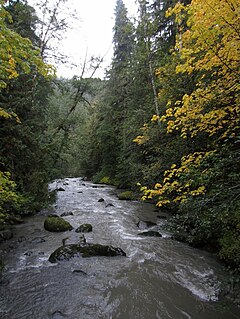
The Dungeness River is a 28-mile (45 km) long river located in the Olympic Peninsula in the U.S. state of Washington. It rises near Mount Constance in the Olympic Mountains within the Olympic National Park, flows through the Buckhorn Wilderness, passes by the town of Sequim, and empties into the Strait of Juan de Fuca at Dungeness Bay, behind the Dungeness Spit. One of its main tributaries is the Gray Wolf River. It is crossed by the Dungeness River Bridge.

Dungeness Spit is a 6.8-mile (10.9 km) long sand spit jutting out from the northern edge of the Olympic Peninsula in northeastern Clallam County, Washington, USA, into the Strait of Juan de Fuca. It is the longest natural sand spit in the United States. The body of water it encloses is called Dungeness Bay. The Dungeness Spit is entirely within the Dungeness National Wildlife Refuge and home of the New Dungeness Lighthouse. Its land area, according to the United States Census Bureau, is 1,271,454 square meters. The lighthouse once was run by United States Coast Guard, but in 1976 the agency installed an automatic light. Since 1994 the lighthouse has been staffed and maintained by the volunteer "New Dungeness Light Station Association". The spit is open to the public year around.

The Dungeness crab, Metacarcinus magister or Cancer magister, is a species of crab that inhabits eelgrass beds and water bottoms on the west coast of North America. It typically grows to 20 cm (7.9 in) across the carapace and is a popular seafood. Its common name comes from the port of Dungeness, Washington, where it is "a prized crustacean that supports the most valuable fishery on the west coast", and where ocean acidification threatens the marine environment.
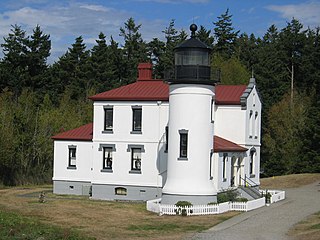
The Admiralty Head Light is a deactivated aid to navigation located on Whidbey Island near Coupeville, Island County, Washington, on the grounds of Fort Casey State Park. The restored lighthouse overlooks Admiralty Inlet. It was the companion to the Point Wilson Light, which sits four miles away on Admiralty Inlet's western shore.

Cumberland Island, Georgia, is the largest of the Sea Islands of the southeastern United States. The long-staple Sea Island cotton was first grown here by a local family, the Millers, who helped Eli Whitney develop the cotton gin. With its unusual range of wildlife, the island has been declared a National Park and a National Seashore. Little Cumberland Island is connected to the main island by a marsh. John F. Kennedy Jr. and Carolyn Bessette were married in the First African Baptist Church on Cumberland Island in 1996.
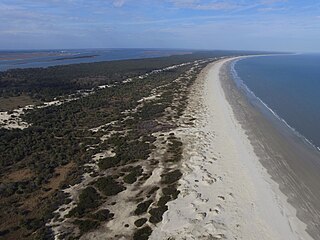
Cumberland Island National Seashore preserves most of Cumberland Island in Camden County, Georgia, the largest of Georgia's Golden Isles. The seashore features beaches and dunes, marshes, and freshwater lakes. The national seashore also preserves and interprets many historic sites and structures.
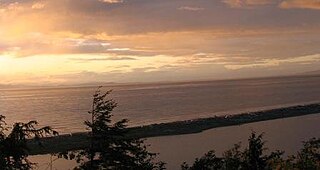
Dungeness is an unincorporated community in Clallam County, Washington, United States, located north of Sequim and on the Strait of Juan de Fuca. Dungeness has a number of waterfront residential communities, but also features the Dungeness Spit, a popular destination for locals and tourists. The name "Dungeness" refers to the Dungeness headland in England. It was given by George Vancouver in 1792, who wrote: "The low sandy point of land, which from its great resemblance to Dungeness in the British Channel, I called New Dungeness."
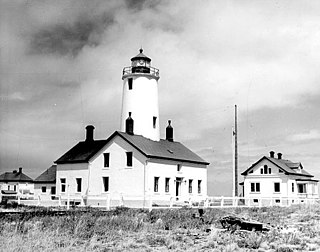
The New Dungeness Light is a functioning aid to navigation on the Strait of Juan de Fuca, located on the Dungeness Spit in the Dungeness National Wildlife Refuge near Sequim, Clallam County, in the U.S. state of Washington. It has been in continuous operation since 1857, although the current lighthouse tower is 26 feet (7.9 m) shorter than when first constructed.
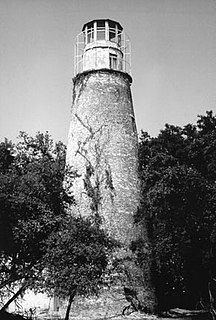
The Little Cumberland Island Lighthouse is a privately owned lighthouse in Georgia, United States, on the north end of Little Cumberland Island adjacent to main Cumberland Island, in Camden County on the southeast coast of Georgia.
William Henry Blake (1837–1871) was the first New Dungeness Lighthouse keeper. Blake began his term after the New Dungeness Lighthouse was first lighted on December 14, 1858. Blake overcame the loneliness and dreariness associated with the profession of lighthouse keeping, serving for over a decade as the New Dungeness light's only attendant. He steadfastly kept the kerosene lantern lighted each night, and tolled the large bell constantly when fog rolled in to warn mariners away from the spit. In 1862 he married Mary Ann McDonnell. Blake is considered to be one of the first and best examples of commitment to mariners' safety.

The Pilot Inn railway station was a station on the Romney, Hythe and Dymchurch Railway in Kent, England.

The Dungeness National Wildlife Refuge is located near the town of Sequim in Clallam County in the U.S. state of Washington, on the Strait of Juan de Fuca. The refuge is composed of 772.52 acres (312.63 ha) which include Dungeness Spit, Graveyard Spit, and portions of Dungeness Bay and Harbor. Dungeness Spit is one of the world's longest natural sand spits, 6.8 miles (10.9 km) long and very narrow. A lighthouse, the New Dungeness Light, built in 1857, is located near the end of the spit. Access to Dungeness Spit is through a Clallam County Park which has hiking trails, picnic areas, and a campground. On January 20, 1915, it was designated as a National Wildlife Refuge by President Woodrow Wilson. Dungeness is one of six refuges in the Washington Maritime National Wildlife Refuge Complex.
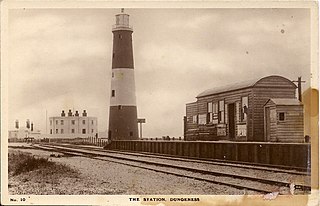
Dungeness was a railway station which served the Dungeness headland in Kent, England. Opened in 1883 by The Lydd Railway Company, it closed to passengers in 1937. Part of the line which served the station is converted to the main access road as a means of transporting atomic waste from nearby Dungeness nuclear power station.

Punta Dúngeness is a headland at the eastern entrance of the Strait of Magellan on its north shore, opposite Cabo del Espiritu Santo in Tierra del Fuego. West of the Punta Dungeness lies the Bahía Posesión. Punta Dungeness marks the border between Chile and Argentina, and according to the Treaty of Peace and Friendship the line between Punta Dungeness and Cabo del Espiritu Santo marks the limits of each country's territorial waters and the border between the Pacific and Atlantic ocean. It is the southernmost point on the mainland of Argentina, and the easternmost point on the mainland of Chile. There is a lighthouse on the Chilean side. This is the only place where the Atlantic Ocean touches the shores on the mainland of Chile, at the entrance to the Strait of Magellan.

Brookland Halt was a railway station which served the village of Brookland in Kent, England. The station opened in 1881 and closed in 1967.

Dungeness on Cumberland Island, Georgia, is a ruined mansion that is part of a historic district that was the home of several families significant in American history. James Oglethorpe first built on Cumberland Island in 1736, building a hunting lodge that he named Dungeness. Oglethorpe named the place after Dungeness, in England. The next Dungeness was the legacy of Revolutionary War hero Nathanael Greene, who had acquired 11,000 acres (45 km2) of island land in exchange for a bad debt. In 1803, his widow Catharine Littlefield Greene built a four-story tabby mansion over a Timucuan shell mound. During the War of 1812 the island was occupied by the British, who used the house as a headquarters.

Dungeness Lighthouse on the Dungeness Headland started operation on 20 November 1961. Its construction was prompted by the building of Dungeness nuclear power station, which obscured the light of its predecessor which, though decommissioned, remains standing. The new lighthouse is constructed of precast concrete rings; its pattern of black and white bands is impregnated into the concrete. It remains in use today, monitored and controlled from the Trinity House Operations and Planning Centre at Harwich, Essex.

Duck house may also refer to a dwelling in a duck pond


















